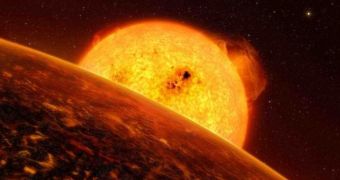According to a new computer simulation of the conditions on the remote exoplanet COROT-7b, it may be that its atmosphere has nothing in common with our own. While we may be accustomed to rain, clouds, winds, fog and snow, we would have a very hard time finding these phenomena on another planet. COROT-7b was discovered early last year, in February, by the CoRoT space observatory, managed by the French and European space agencies (ESA). The models show that rain may exist in the planet's atmosphere, albeit not made out of water, but of small pebbles.
Because the celestial body is located very close to its parent star, it is tidally locked with it. This means that it always has the same face pointed at it, regardless of its orbital position. For the sake of perspective, the Moon is also tidally locked with our planet. We always see the same face of the satellite, while another one remains perpetually obscured. In the case of COROT-7b, the face pointing towards the star is extremely hot, and this creates peculiar phenomena in the atmosphere, including the pebble rain.
The mechanisms that lead to the formation of these structures are actually fairly straightforward, astrophysicists and planetary scientists say. The atmosphere itself contains the main ingredients that form rocks, and, when subjected to an incoming front, such as solar flares, pebbles simply condense from this matter, and then rain down in the lakes of molten lava below. Details of the computer simulation appear in the October 1st issue of The Astrophysical Journal.
In charge of the research were Washington University in St. Louis experts Laura Schaefer, who is a Planetary Chemistry Laboratory research assistant, and Bruce Fegley Jr., a Department of Arts & Sciences professor of earth and planetary sciences. They say that COROT-7b is most similar to our planet of all the nearly 400 exoplanets thus far discovered. It only has twice the size and five times the mass of the Earth, they add. It was found circling an orange dwarf, in the constellation Monoceros, ScienceDaily reports.
“The only atmosphere this object has is produced from vapor arising from hot molten silicates in a lava lake or lava ocean. Sodium, potassium, silicon monoxide and then oxygen – either atomic or molecular oxygen – make up most of the atmosphere. As you go higher the atmosphere gets cooler and eventually you get saturated with different types of 'rock' the way you get saturated with water in the atmosphere of Earth. But instead of a water cloud forming and then raining water droplets, you get a 'rock cloud' forming and it starts raining out little pebbles of different types of rock,” Fegley explains.

 14 DAY TRIAL //
14 DAY TRIAL //